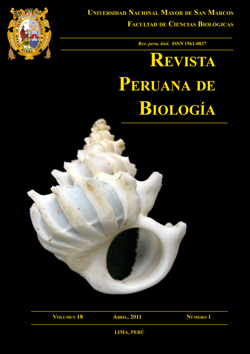Reproduction and diet of a population of Mabuya dorsivittata (Squamata, Scincidae) in Cordoba, Argentina
DOI:
https://doi.org/10.15381/rpb.v18i1.149Keywords:
Mabuya, reproduction, diet, sexual dimorfism, ArgentinaAbstract
The reproduction and diet were studied in Mabuya dorsivittata a viviparous lizard from Alto Alegre (Córdoba). The smallest female with yolking ovarian follicles measured (svl) 41 mm, and the smallest male with spermatozoa in the testes measures (svl) 31mm. The litter size was from five to ten embryos. A positive and significant correlation existed between the weight of the eggs or embryos and the reproductive state (B = 0,524, R = 0,254, P 0,001). In males there was a positive and significant correlation between the testicular volume and the reproductive state (R2 = 0,851, b= 0,929, P= 0,002). The mass of fat bodies in females and males was related with the reproductive period, especially in the females, diminishing in the final phases of embryo development, indicating a high energetic cost during the last months of embryonic growth. Regarding the diet, females fed mainly on soil Araneae as fundamental prey, Scarabeidae, Araneae (others) and Acridiidae as secondary prey, whereas males fed on Isopoda, Acridiidae and Araneae as fundamental prey and on Tettigonidae as secondary prey. There were significant differences in trophic selection among sexes.Downloads
Downloads
Published
Issue
Section
License
Copyright (c) 2011 Liliana Aun, Damiana Borghi, Ricardo Martori

This work is licensed under a Creative Commons Attribution-NonCommercial-ShareAlike 4.0 International License.
AUTHORS RETAIN THEIR RIGHTS:
a. Authors retain their trade mark rights and patent, and also on any process or procedure described in the article.
b. Authors retain their right to share, copy, distribute, perform and publicly communicate their article (eg, to place their article in an institutional repository or publish it in a book), with an acknowledgment of its initial publication in the Revista Peruana de Biologia.
c. Authors retain theirs right to make a subsequent publication of their work, to use the article or any part thereof (eg a compilation of his papers, lecture notes, thesis, or a book), always indicating its initial publication in the Revista Peruana de Biologia (the originator of the work, journal, volume, number and date).






